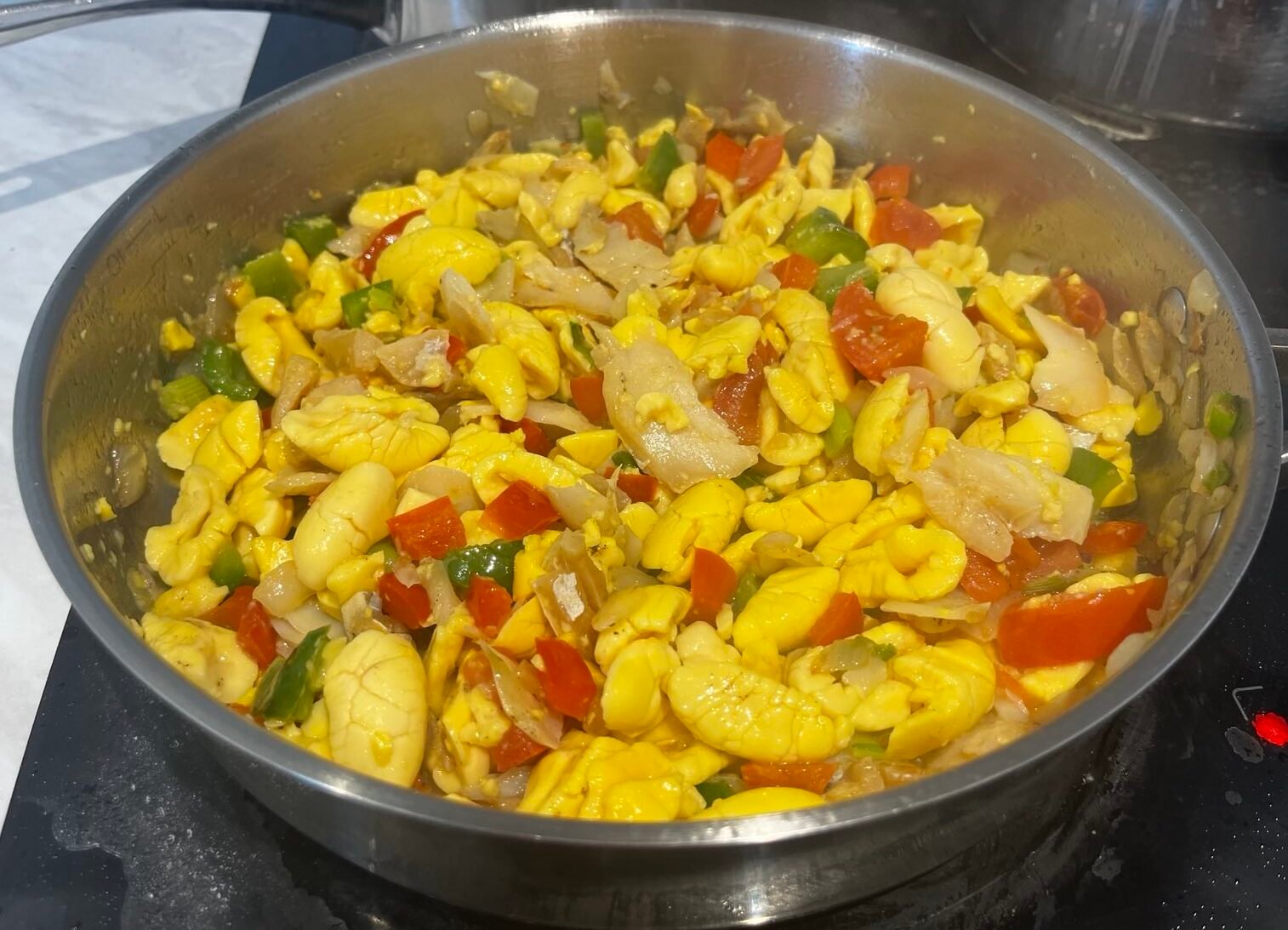Jamaican Ackee and Saltfish Recipe
Welcome to a taste of Jamaica!
Today, we’re exploring one of Jamaica’s most beloved dishes, Ackee and Saltfish.
We will be using an easy Jamaican Ackee and Saltfish recipe to make this dish.
Ackee and Saltfish holds a special place in the heart of Jamaicans, celebrated not only for its delightful taste but also for its historical significance. Introduced to the Caribbean from West Africa, ackee, when paired with the salted, preserved cod brought by European traders, symbolizes a unique blend of influences that have shaped Jamaican culture and cuisine.
Proudly recognized as Jamaica’s national dish, Ackee and Saltfish connects Jamaicans to their history and identity, whether they’re on the island or part of the vast diaspora. It’s more than food; it’s a culinary celebration of survival, adaptation, and creativity.
So, let’s dive into how this iconic dish is made and discover why it continues to be a symbol of Jamaican pride wherever it’s served.
Historical Background
Let’s step back in time and explore the fascinating origins of Ackee and Saltfish.
Ackee, the bright yellow fruit, began its journey in West Africa and was brought to Jamaica in the 18th century. Its introduction to the island marked the beginning of what would become a culinary mainstay.
As for saltfish, it entered the scene through colonial trade routes. Salted cod was preserved and transported by European traders, primarily from North Atlantic fisheries, to feed enslaved and indentured laborers across the Caribbean. This preservation technique made saltfish a practical and essential protein source in the tropical climate.
When these two ingredients—ackee and saltfish—met, they created more than just a dish; they symbolized a fusion of African and European influences, reflecting the complex layers of Jamaica’s colonial history. Over time, this combination evolved into a beloved staple of Jamaican cuisine, embodying the island’s ability to blend various cultural elements into something uniquely and richly Jamaican.
Essential Kitchen Tools for Cooking Ackee and Saltfish
Before you dive into cooking Ackee and Saltfish, let’s make sure your kitchen is set up with the right tools. Having these essentials on hand will make the cooking process smoother and more enjoyable. Here’s what you’ll need:
- Large Skillet or Frying Pan: This will be your main cooking vessel where the magic happens—sautéing the saltfish and vegetables to perfection.
- Pot for Boiling: Essential for cooking the ackee, especially if you’re using the fresh variety, as it needs to be boiled before it can be safely eaten.
- Cutting Board and Knife: Prepping your ingredients with a good knife and stable cutting board makes all the difference. You’ll need these for chopping onions, tomatoes, and peppers, as well as mincing garlic.
- Bowls for Ingredients: Keep different ingredients ready and organized. Using separate bowls for your chopped veggies, minced garlic, and spices will streamline the cooking process and keep you organized.
With these tools at the ready, you’ll be all set to tackle this delicious Jamaican dish with ease and confidence. Let’s get cooking!
Ingredients List
To bring the vibrant flavors of Jamaica’s national dish into your kitchen, you’ll need the following ingredients for Ackee and Saltfish. Whether you choose to stick with the basics or add a few optional items for extra depth and savor, each component plays a vital role in crafting this traditional dish:
- Ackee: Opt for fresh ackee if it’s available to you, but canned ackee works just as well and is easier to find internationally.
- Salted Cod (Saltfish): This is the heart of the dish, providing a rich, salty contrast to the creamy ackee.
- Cooking Oil: Vegetable or coconut oil is preferred for frying and sautéing, lending a subtle flavor that complements the other ingredients.
- Onions: A must for their sweetness and depth, onions form the foundational flavor base of the dish.
- Tomatoes: Fresh tomatoes add a juicy, tangy element that balances the saltiness of the fish.
- Scotch Bonnet Pepper: For authentic Jamaican heat and spice, a bit of finely chopped Scotch bonnet is key. Handle with care!
- Bell Peppers: These are optional but recommended for adding color and a mild, sweet flavor.
- Garlic: A few cloves, minced, to enrich the dish with aromatic warmth.
- Thyme: Essential for its earthy, slightly minty notes that are characteristic of Caribbean cooking.
- Black Pepper: For a simple, robust seasoning that ties all the flavors together.
- Optional Extras: Scallions can be sprinkled on top for a fresh, oniony crunch.
Gather these ingredients, and you’re well on your way to creating a deliciously authentic Jamaican Ackee and Saltfish. Each element brings its own unique flavor, making the dish a true celebration of taste and texture.
Preparing The Ingredients
Preparing the ingredients for Ackee and Saltfish is an essential step that sets the stage for this flavorful dish. Here’s how to get everything ready for cooking:
1. Desalt the Saltfish
Saltfish is quite salty, so it needs to be desalted before cooking:
- Soak the Saltfish: Rinse the saltfish under cold water to remove any surface salt. Then, soak it in cold water for about 1 hour, depending on its thickness or soak it overnight.
- Boil the Saltfish: After soaking, place the saltfish in a pot, cover with fresh water, and bring to a boil. Reduce the heat and simmer for about 20 minutes to soften the fish and remove more salt.
- Shred the Saltfish: Once cool enough to handle, flake the fish into pieces, removing any bones and skin.
- Note: If the saltfish has been soaked overnight, the boiling time typically reduces since the soaking process helps to soften the fish and remove much of the salt.
- Also, if you’ve soaked the saltfish overnight, you may need to add a little salt to the dish, as the soaking can reduce its saltiness. However, the saltfish typically retains enough salt to sufficiently season the dish.
2. Prepare the Ackee
If you’re lucky enough to get your hands on fresh ackee, it needs careful handling:
- Wait for Ackee to Ripen: Ackee must be fully opened naturally on the tree. Unripe ackee is toxic, so never force open the closed ackee pods.
- Boil the Ackee: Remove the black seeds and the red membrane. Wash the ackee lobes in cold water, then boil them in clean water for about 10-15 minutes until tender but firm. Be careful not to overcook, as they should hold their shape. Drain well.
If you are using canned ackee:
- Drain the Ackee: Open the can by using a can opener and drain the liquid. Pour the ackee into a colander or sieve to remove all excess moisture.
- Inspect and Rinse: Check the ackee for any seeds or membranes left, and rinse gently under cold water to freshen it up and remove any canned taste.
- Handle Gently: Canned ackee is precooked and delicate. Handle carefully to avoid breaking the lobes.
- Set it aside: After rinsing, set the ackee aside until ready to be added to your dish.
This simple process will help you incorporate canned ackee smoothly into your recipe, while preserving its texture and enhancing your dish with its delicious flavor.
3. Chopping and Preparing Vegetables and Seasonings
Getting your veggies and seasonings ready:
- Chop Onions and Tomatoes: Peel and finely chop the onions. Dice the tomatoes into small pieces.
- Minced Garlic and Scotch Bonnet Pepper: Peel and mince the garlic cloves. Finely chop the Scotch bonnet pepper, removing the seeds if you prefer less heat.
- Slice Bell Peppers: If using, seed and slice the bell peppers into strips or small pieces.
- Measure Out Seasonings: Prepare your thyme, black pepper, and any other seasonings you plan to use.
By following these steps, your ingredients will be perfectly prepared, ensuring that your Ackee and Saltfish turns out deliciously every time. Now, you’re ready to start cooking this classic Jamaican dish!
How To Cook Ackee And Saltfish
Now that you’ve prepared your ingredients, let’s walk through the cooking process step by step. This will ensure your Ackee and Saltfish turns out just right—flavorful, comforting, and authentically Jamaican.
Step 1: Boiling and Preparing the Ackee
- Fresh Ackee: If using fresh ackee, you’ve already boiled it during preparation. Fresh ackee should be soft but still firm after boiling, ensuring it doesn’t disintegrate during the final cooking.
Canned ackee: The canned ackee is already drained and set aside during preparation. Since it is precooked, it does not require prolonged cooking and will need to warm through, ensuring it doesn’t break apart.
Step 2: Sautéing the Saltfish with Onions, Garlic, and Peppers
- Heat the Oil: In a large skillet or frying pan, heat the cooking oil over medium heat.
- Sauté the Onions and Garlic: Add the chopped onions and minced garlic to the hot oil. Sauté until the onions become translucent and fragrant.
- Add the Saltfish: Incorporate the flaked saltfish, stirring gently to mix it with the onions and garlic.
- Include Peppers and Tomatoes: Add the chopped Scotch bonnet pepper, bell peppers (if using), and tomatoes. Cook for about 5-7 minutes, allowing the flavors to meld.
Step 3: Combining Ingredients and Final Seasonings
- Fold in the Ackee: Gently fold the ackee into the skillet, being careful not to stir too vigorously to avoid breaking the ackee lobes.
- Season the Dish: Sprinkle thyme and black pepper over the mixture. If you included Scotch bonnet pepper earlier, it should be spicy enough, but you can adjust according to your taste.
- Simmer Gently: Allow everything to simmer together for a few more minutes so the flavors can fully integrate. Adjust the heat if necessary to prevent sticking or burning.
Note: Fold in the Ackee means using a spatula or a large spoon to lightly lift and turn the mixture from the bottom to the top. This technique helps to incorporate the ackee without mashing or breaking its soft lobes, keeping the texture of the dish intact and ensuring that everything is evenly mixed without mashing the ackee.
Tips for Adjusting Spice Levels and Avoiding Common Pitfalls
- Spice Adjustment: If you’re worried about the dish being too spicy, start with a small piece of Scotch bonnet pepper and add more as needed. Remember, it’s easier to add spice than to take it away.
- Avoiding Pitfalls: Be gentle when folding in the ackee to keep the lobes intact. Over-stirring can cause the ackee to break apart and turn mushy, which affects the texture of the final dish.
Serving Suggestions
Once your Ackee and Saltfish is ready, presenting and serving it in the right way can make all the difference. Here’s how to serve up this delicious dish with flair and flexibility, making it perfect for any meal or occasion.
Traditional Accompaniments
Ackee and Saltfish pairs wonderfully with a variety of sides that enhance its flavors and textures:
- Fried Dumplings: These fluffy, golden treats are a crispy contrast to the softness of the ackee.
- Johnny Cakes: Another fried delight, these are slightly sweet and make for a perfect breakfast or brunch side.
- Boiled Green Bananas: A staple in Jamaican cuisine, their mild flavor and starchy texture complement the richness of the saltfish.
- White Rice: For a simpler side, fluffy white rice works beautifully to soak up the flavors.
Meal Suggestions
Ackee and Saltfish is versatile enough to fit any dining occasion, including breakfast or brunch, lunch, dinner, or casual gatherings. Here are some meal suggestions:
- Serve with fritters or fried dumplings
- Serve with fried or roasted breadfruit
- Serve with bammy or festivals
- Serve with boiled green bananas and boiled dumplings
- Serve with white rice and a mixed vegetable sauté or avocado
- Serve buffet style, allowing guests to mix and match their sides according to their preferences.
By following these serving suggestions, you’ll not only honor the tradition of the dish but also tailor it to fit the setting and your guests’ tastes, ensuring that everyone enjoys this classic Jamaican meal to its fullest.
FAQs
Ackee and Saltfish is a beloved dish with a rich history and delicious taste. However, when preparing this Jamaican ackee and saltfish recipe, you may have a few questions, especially regarding ingredient substitutions and the best ways to store and reheat leftovers. Here are answers to some common queries that might help:
Substitutions and Variations
Q: Can I use something other than saltfish if I don’t eat seafood?
A: Absolutely! For a vegetarian version, you can substitute saltfish with firm tofu, mushroom or a seasoned vegetable mix.
Q: What if I can’t find fresh ackee?
A: Canned ackee is a great alternative and widely available in international or Caribbean markets. It’s pre-cooked, so just drain and add to your dish at the last cooking step to heat through as explained in the coking instructions above.
Q: Is there a substitute for Scotch bonnet pepper if I can’t handle the heat?
A: Yes, you can use a milder pepper like jalapeño or omit the hot peppers altogether. You can also add just a touch of pepper for flavor without much of the heat.
Storing and Reheating
Q: What’s the best way to store leftover Ackee and Saltfish?
A: Let the dish cool to room temperature before storing it in an airtight container. It can be refrigerated for up to three days. Ensure it’s tightly sealed to maintain freshness.
Q: Can I freeze Ackee and Saltfish?
A: Freezing is not recommended for ackee, as it can alter the texture and flavor significantly. However, the saltfish mixture can be frozen separately if needed.
Q: How should I reheat Ackee and Saltfish?
A: Reheat leftovers gently in a skillet over medium heat. Add a splash of water or oil to help rehydrate the fish and ackee without drying them out. Stir gently to avoid breaking the ackee. Microwave reheating might cause the ackee to become too mushy, so heating on the stove is preferable.
These tips and answers should help you navigate the intricacies of cooking and enjoying Ackee and Saltfish, making your experience as enjoyable as possible!
Happy Cooking!
If you enjoyed this Jamaican ackee and salt fish recipe, please take a moment to scroll down and leave a comment and review!
Jamaican Ackee and Saltfish Recipe
Cuisine: Jamaican4
servings20
minutes35
minutes200
kcalIngredients
1 can of ackee, drained (540 grams) or 2 cups of fresh ackee
1/2 pound salted cod (saltfish), soaked and flaked
2 tablespoons vegetable or coconut oil
1 onion, finely chopped
2 cloves garlic, minced
1 ripe tomato, chopped
1 Scotch bonnet pepper, deseeded and sliced (optional)
1 bell pepper, julienned
1 teaspoon dried thyme
1/2 teaspoon freshly ground black pepper
Optional: 2 scallions, sliced for garnish
Instructions
- Prepare the Saltfish:
● Soak saltfish for a minimum of 2 hours.
● Drain, then boil in fresh water until tender. Drain again and flake the fish, removing any bones. - Cook the Vegetables:
● Heat oil in a large skillet over medium heat.
● Sauté onions and garlic until onions are soft.
● Add tomatoes, Scotch bonnet pepper, bell peppers, and thyme. Continue cooking until vegetables are soft. - Combine and Cook:
● Gently fold in the flaked saltfish and ackee, being careful not to stir too much to avoid breaking the ackee.
● Season with black pepper and cook for an additional 5-7 minutes, or until everything is heated through. - Serve:
● Garnish with sliced scallions if desired.
● Serve hot with sides like fried dumplings, boiled green bananas, or steamed white rice.
Notes
- 1. If using fresh ackee, ensure it is fully ripe (naturally opened on the tree) and boiled until tender before adding to the dish.
- 2. Adjust the amount of Scotch bonnet pepper to control the spice level according to your preference.
- 3. If you’ve soaked the saltfish overnight, you may need to add a little salt to the dish, as the soaking can reduce its saltiness.








